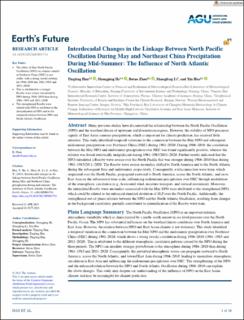| dc.description.abstract | Many previous studies have documented the relationship between the North Pacific Oscillation (NPO) and the weather/climate of upstream and downstream regions. However, the stability of NPO precursor signals of East Asian summer precipitation, which is important for climate prediction, has received little attention. This study identified temporal variations in the connection between the May NPO and subsequent midsummer precipitation over Northeast China (NEC) during 1961–2020. During 1986–2010, the correlation between the May NPO and midsummer precipitation over NEC was found significantly positive, whereas the relation was found statistically insignificant during 1961–1985/2011–2020. Further results indicated that the NPO stimulated a Rossby wave source over the North Pacific that was stronger during 1986–2010 than during 1961–1985/2011–2020. The Rossby wave source anomalies shifted to North America and to the North Atlantic during the subsequent June and midsummer, respectively. Consequently, a teleconnection wave train, which originated over the North Pacific, propagated eastward to North America, across the North Atlantic, and on to East Asia on the subseasonal time scale, influencing midsummer precipitation over NEC through modulation of the atmospheric circulation (e.g., horizontal wind, moisture transport, and vertical movement). Moreover, the intensified Rossby wave anomalies associated with the May NPO were attributed to the strengthened NPO, which could be related to the enhanced standard deviation of SLP over the North Pacific. Additionally, the strengthened out-of-phase relation between the NPO and the North Atlantic Oscillation, resulting from changes in the background circulation, partially contributed to intensification of the Rossby wave train. | en_US |

